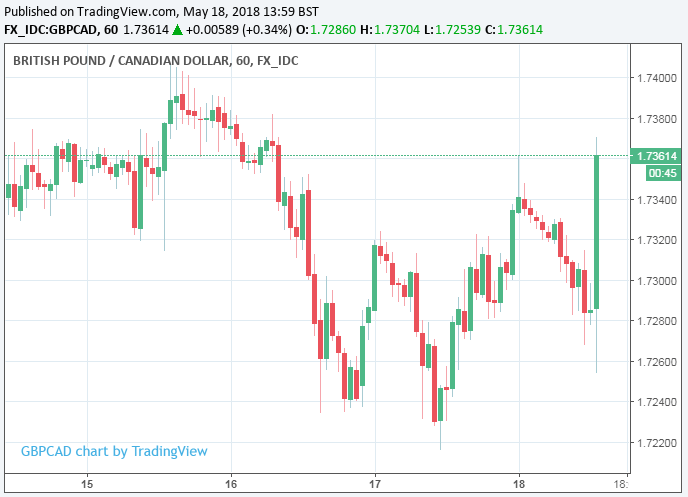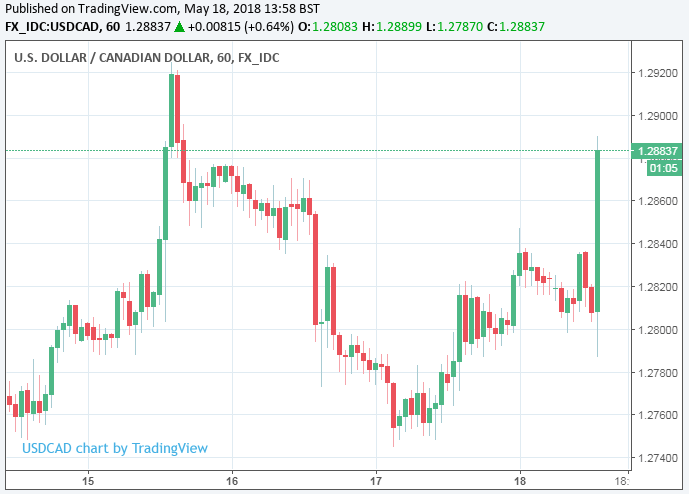Canadian Dollar Slumps after Inflation Holds Steady in April and Consumer Spending Slips
- Written by: James Skinner
-
-CAD reverses course and heads lower on disappointing data.
-Inflation dips to 2.2% and core-retail sales post surprise fall in March.
-Focus now on the BoC, oil prices, NAFTA and CAD bond-buyers' strike.

© thanasak, Adobe Stock
The Canadian Dollar reversed course and slumped during the noon session Friday after data showed a surprise contraction in the value of Canadian retail sales at the end of the first-quarter and a minor fall in April inflation.
This has overshadowed the rising oil prices, which are now at multi-year highs, and optimism over a deal to save the North American Free Trade Agreeement that had previously supported the currency.
Statistics Canada data showed "core" Canadian retail sales, which exclude automobiles from the figures, contracting by -0.2% during March when markets had been looking for them to rise by 0.5%.
Total retail sales rose by 0.6% during the month, much faster than the 0.3% growth forecast, but this number includes sales of large ticket items like cars that are excluded from the "core" figure given their distortionary effect on underlying trends.
"Canadian retailing moved higher after a few flat months late last year and in early 2018, although you had to be selling cars to feel that lift in March. Overall retail sales climbed 0.6%, but strip out auto dealers, and sales came in well below consensus with a 0.2% decline," says Avery Shenfeld, chief economist at CIBC Capital Markets.
Separately, data showed Canadian inflation rising in-line with expectations and at a rate of 0.3% in April, although the annual pace of consumer price inflation dipped 10 basis points to 2.2%. All measures of "core inflation", which exclude volatile items like food and energy, also held steady at their March levels of around 2%.
These numbers are still at or above the Bank of Canada's 2% target which, in ordinary times, might have prompted markets to bet on an imminent interest rate rise. But the slowdown in consumer spending and earlier suggestions from the BoC that it is willing to tolerate an "overshoot" mean this hasn't happened.
"For the loonie, we think the Bank's acceptance of an inflation overshoot muddies the water on higher inflation. If the Bank does not respond with higher nominal rates, real rates will push lower. That feeds into a weaker CAD," says Fred Demers, chief Canada macro strategist at TD Securities.

Above: Pound-to-Canadian-Dollar rate shown at hourly intervals.
The USD/CAD rate quoted 0.40% higher at 1.2886 following the release after reversing an earlier 0.24% loss, which denotes a sudden weakening of the Loonie, while the Pound-to-Canadian-Dollar rate swung from a 0.38% loss that had seen it trading around 1.7274 to a 0.08% gain that pushed the rate up to 1.7359.

Above: USD/CAD shown at hourly intervals.
Markets care about the retail and inflation data because it has significant influence over Bank of Canada policy decisions and it is interest rates that are the raison d'être for most moves in exchange rates.
Changes in rates, or hints of them being in the cards, are only made in response to changes in domestic inflation but impact currencies because of the push and pull influence they have on international capital flows and their allure for short-term speculators.
Pricing in interest rate derivatives markets suggests investors currently looking to July and November for the next interest rate rises from the Bank of Canada, which would leave the Canadian cash rate at 1.75%. It would take a substantial improvement in the Canadian economic outlook, or increase in inflation, to shift these odds in favour of further Loonie strength. Conversely though, it might not take much more bad news to see those odds move against the currency.
"We have become more confident that the BoC is likely to deliver two more rate hikes this year. The next hike could still come as early as at the end of this month, although the BoC are expected to wait until July. A stronger than expected CPI report today will likely be required to prompt the market to price in a higher probability of a hike this month," says Lee Hardman, a currency analyst at MUFG.
Advertisement
Get up to 5% more foreign exchange by using a specialist provider to get closer to the real market rate and avoid the gaping spreads charged by your bank when providing currency. Learn more here.
Buyers' Strike Threatens Canadian Bonds and Currency
The Canadian Dollar has been among the best performing currencies during recent weeks as hopes of a NAFTA breakthrough have risen and afterPresident Donald Trump's decision to pull out of the so called Iran nuclear deal helped send oil prices to their highest levels since early 2015.
This has seen the Canadian Dollar partially protected from a resurgent US Dollar, which has advanced relentlessly against all other currencies during recent weeks in response to a sudden lift in American bond yields.
As a result the USD/CAD rate has dropped 2% in the last month, denoting a resilient Loonie, during a period when the broader Dollar index has converted a 4% 2018 loss into a 1.68% gain.
However, given Brent, West Texas Intermediate and Western Canada Select crude oil benchmarks have risen by double digit numbers this year, many strategists are flagging that the USD/CAD rate and broader Canadian Dollar should be a lot higher than they are now. Oil is, after all, Canada's largest export.
"The building geopolitical tensions in the Middle East are supportive for oil-related currencies such as the Canadian dollar. Based on the price of oil alone, we estimate that USD/CAD should be trading closer to 1.2000 rather than 1.3000," notes MUFG's Hardman.
Analysts at National Bank of Canada have a theory about why the Loonie is under-performing its potential, which could have significant implications for the Loonie during the months ahead if proven correct. They argue the Canadian Dollar's perceived under-performance stems from a sudden strike among foreign holders of Canadian government bonds.
"It’s been 15 years since we’ve seen such an extended period of net foreign selling," says Warren Lovely, a fixed income strategist at National Bank of Canada. "During the first quarter of 2018, we had $3.1 billion of net foreign selling of Canadian bonds... standing in marked contrast to the $25.5 billion of net buying recorded over the same period last year."
This "net selling" isn't simply the result of bonds maturing and overseas debt holders then taking their cash back from the Canadian government and going off to invest it elsewhere. A substantial majority of this selling is taking place in the "secondary market" and involves bonds that are not yet at their maturity date.
"The big reduction in foreign activity in Canadian bonds was about weaker secondary market interest... not only heavy selling in our sovereign bond market but a lightening up/reduced interest in outstanding Crowns, provincials and municipals too," Lovely says.
That has seen Canada shift from having a "net portfolio inflow" during the first quarter of last year to a net portfolio outflow in 2018. If this marks the beginning of a trend then it would mean the Canadian Dollar experiences continued selling pressure during the months ahead and Canadian government bond yields would likely have to rise in order for the country to attract new capital. That would impact interest rates within the real economy and hamper economic growth.
"This deterioration in one part of our balance of payments might help explain why the C$ hasn’t kept pace with the demonstrated pick-up in oil prices... although clearly Canada’s negative interest rate spreads vs the US and still-elevated geopolitical uncertainty (e.g., NAFTA worries) are also holding the loonie back," the strategist adds.
Advertisement
Get up to 5% more foreign exchange by using a specialist provider to get closer to the real market rate and avoid the gaping spreads charged by your bank when providing currency. Learn more here.
NAFTA: Deal or No Deal?
Friday's price action in the currency market comes as Brent and WTI crude oil futures reached new three year highs and just hours after one of many deadlines for the renegotiation of NAFTA passed without an deal being reached.
US trade representative Robert Lighthizer was quoted by the FT late on Thursday as saying; “The Nafta countries are nowhere near close to a deal...We of course will continue to engage in negotiations, and I look forward to working with my counterparts to secure the best possible deal for American farmers, ranchers, workers, and businesses."
These comments came after House Speaker Paul Ryan said last week that US, Mexican and Canadian negotiators have until the end of Thursday 17, May to agree a new NAFTA deal if they want it to be passed through the US Congress before January 2018, which is when the new Congressmen elected in the November midterms will take up their seats.
Currency markets have taken the absence of progress in the NAFTA talks in their stride during recent weeks however, as the July 01 Mexican election draws closer, the prospects of a deal risk moving further away.
The vote will see incumbent President Enrique Pena Nieto, who is prohibited by the Mexican constitution from running again, replaced with ruling Institutional Revolutionary Party (PRI) candidate Jose Antonio Meade or by opposition candidate Andres Manuel Lopez Obrador, who has campaigned heavily on an anti-corruption ticket and is a firm favourite in opinion polls to win the presidency.
Obrador has previously called for talks to be suspended until after the election because, according to a CBC report, the "weak" incumbent president is in danger of "selling out" the country. This suggests the Mexican stance toward President Donald Trump's demands may harden in July if Obrador is succesful in his campaign for the presidency, which would increase the risk that President Trump simply withdraws from the pact.
Negotiating a new NAFTA deal is important for the Loonie because analysts have previously estimated a withdrawal by the US could hit the Canadian economy and see the currency fall by as much as 20%. A potential withdrawal has been in the cards ever since the election of President Trump, who once described it as "the worst deal in history" while on the campaign trail and pledged to tear it up if Canada and Mexico wouldn't agree to a new deal with more palatable terms.
Advertisement
Get up to 5% more foreign exchange by using a specialist provider to get closer to the real market rate and avoid the gaping spreads charged by your bank when providing currency. Learn more here.










